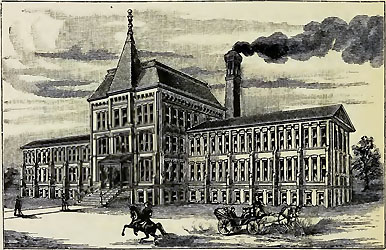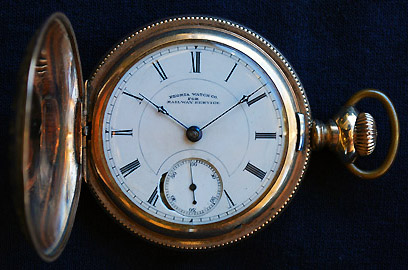Peoria Watch Co. Peoria, Illinois
 The Howard Brothers, Fredonia, New York
The Howard Brothers, Fredonia, New York
Brothers Edward D. and Clarence M. Howard owned a mail-order catalog business selling watches, jewelry and Pettit's Eye Salve. The watches were manufactured for them by several American watch manufactures and engraved Independent Watch Co.
In April 1880 the Howard Bros. decided to make their own watch movements rather than just buying watches manufactured by others. The Independent Watch Company of Fredonia, New York, was incorporated and began manufacturing watches using machinery and designs which were merged from the Newark Watch Company, Newark, New Jersey and United States Watch Company of Marion, New Jersey.
In the fall of 1883 J. C. Adams became involved, the company, it was reorganized as the Fredonia Watch Company, machinery was upgraded and a new line of watches was produced, yet sales remained slow.
Peoria Watch Company
The Peoria Watch Company of Peoria, Illinois was incorporated on December 19, 1885 by Clarence Howard, J. C. Adams, Joseph B. Greenhut, Lydia Moss Bradley and several Peoria investors with a capital of $250,000. The Peoria Watch Company purchased the machinery of the Fredonia Watch Company. A new factory building was constructed in Peoria beginning in March 1886 and the machinery purchased from the Fredonia Watch Co. was relocated to the new factory in Peoria in June 1886.
 The former Fredonia model was modified to meet the requirements of a quick-train, 18-size, full plate railroad watch. Several grades of 18-size, quick-train, adjusted movements were produced, catering to the railroad trade. Peoria Watch Co. movements were available as hunting case (model 1) or open face (model 2):
The former Fredonia model was modified to meet the requirements of a quick-train, 18-size, full plate railroad watch. Several grades of 18-size, quick-train, adjusted movements were produced, catering to the railroad trade. Peoria Watch Co. movements were available as hunting case (model 1) or open face (model 2):
- Grade A, Peoria Watch Company's highest grade, was 18-size, nickel movement, adjusted, 15-jewel with raised gold settings, non-magnetic hairspring, engraved "Peoria Watch Co., Anti Magnetic, Superior Quality, 15 Jewels, Adjusted."
- Grade B, was 18-size, nickel movement, adjusted, 15-jewel, non-magnetic hairspring, engraved "Peoria Watch Co., 15 Jewels, For Railway Service, Anti Magnetic, Adjusted."
- Grade H was 18-size, gilt movement, adjusted, 15-jewel, non-magnetic hairspring, engraved either "Peoria Watch Co., 15 Jewels, For Railway Service, Anti Magnetic, Adjusted" or "Peoria Watch Co., 15 Jewels, Anti Magnetic Spring, Adjusted."
- Grade BB was 18-size, nickel movement, adjusted, 15-jewel, steel hairspring, engraved "Peoria Watch Co., 15 Jewels, For Railway Service, Adjusted."
- Grade I was18-size, gilt movement, adjusted, 15-jewel, engraved "Peoria Watch Co., 15 Jewels, For Railway Service, Adjusted."
- Grade C was 18-size, nickel movement, adjusted, 15-jewel, non-magnetic hairspring, engraved either "Peoria Watch Co., 15 Jewels, Hairspring & Escapement Non Magnetic, Adjusted" or "Peoria Watch Co., 15 Jewels, Anti Magnetic Spring, Adjusted."
- Grade G was18-size, gilt movement, adjusted, 15-jewel, non-magnetic hairspring, engraved "Peoria Watch Co., 15 Jewels, Hairspring & Escapement Non Magnetic, Adjusted."
- Grade E was 18-size, nickel movement, adjusted, 15-jewel, steel hairspring, engraved "Peoria Watch Co., 15 Jewels, Adjusted."
- Grade J was 18-size, gilt movement, adjusted, 15-jewel, steel hairspring, engraved "Peoria Watch Co., 15 Jewels, Adjusted."1
By the Summer on 1887 high demand for the new railroad grade watches lead to a delay of six to eight weeks to fill orders. The company employed approximately 90 people and produced about 30 movements per day. Some moderate priced, unadjusted 15-jewel, 11-jewel and 9-jewel watch movements were also produced, all were 18-size. Peoria also manufactured private label watches.
 Non-Magnetic Watch Co. of America
Non-Magnetic Watch Co. of America
In 1888 Peoria entered into an arrangement with A. C. Smith to producing high grade 18-size watch movements for Smith's Non-Magnetic Watch Co. of America. A 1889 advertisement listed three "American Manufactured" 18-size full plate grades:
- No. 43, nickel movement, 15 ruby jewels in gold settings, "adjusted;"
- No. 45, nickel movement, 15-jewel "adjusted;"
- No. 47, gilt movement, 15-jewel "adjusted."
These three Non-Magnetic Watch Co. of America grades included "Paillard's Patent non-magnetic compensation balance and hairspring, and full non-magnetic escapements."2 Four grades of unadjusted 18-size movements were introduced in April 1890. The Non-Magnetic Watch Co. of America was placed in receivership in 1890, however, watches continued to be advertised and sold.
In January 1892 the Non-Magnetic Watch Co. acquired the assets of the Non-Magnetic Watch Co. of America. An October 1892 trade advertisement listed four 18-size grades "especially constructed and adjusted to meet the requirements of railroad service:"
- Grade A.A. Extra, nickel movement, 15 fine ruby jewels, adjusted to five positions;
- Grade A, nickel movement, 15 ruby jewels, adjusted to three positions;
- Grade B, nickel movement, 15 ruby jewels, adjusted to three positions;
- Grade C, gilt movement, 15 ruby jewels, adjusted to three positions.
Peoria only manufactured the 18-size movements, the Non-Magnetic Watch Co. of America and Non-Magnetic Watch Co. 16-size movements were imported from Switzerland.
The Non-Magnetic Watch Co. was placed in receivership in 1893, with a judgment filed in favor of E. D. Howard and others. The Non-Magnetic Watch Co. was bought out by the A.C. Smith Watch Co. in August 1894. In late 1896 the A. C. Beckon Co. began advertising 16-size and 18-size Illinois manufactured watches marked "Paillard Non-Magnetic Watch Co. Chicago, U.S.A."
The Peoria Watch Co. factory closed in 1891-1892. The Fredonia Watch Co. and Peoria Watch Co. produced an estimated 29,800 watch movements, including 13,050 for the Non-Magnetic Watch Co. of America.3
In 1892 the Parsons Horological Institute, the first school for watchmakers in America, which had been founded by J.R. Parsons in 1886, in La Porte, Indiana, moved into the former Peoria Watch Co. factory building. Peoria philanthropist Lydia Moss Bradley had purchased a controlling interest in the school. In 1896 the building, including the remaining watch making machinery, was destroyed by fire. The Parsons horological school moved into a new building in 1897, becoming the Horological Department of Bradley Polytechnic Institute.
For additional reading and references:
Abbott, Henry G. The Watch Factories of America Past and Present: A complete history of Watch Making in America, from 1809 to 1888 Inclusive. Geo. K Hazlitt & Co. Chicago, 1888, reprinted by Forgotten Books, Lexington, KY, 2012.
Crossman, Charles S. The Complete History of Watch Making in America, Reprinted from Jewelers' Circular and Horological Review 1885 - 1887. Adams Brown Co. Exeter, New Hampshire.
Greg Frauenhoff, Serial Numbers and Descriptions of Fredonia and Peoria Watch Co. Movements, Sedalia, CO, 2001.
Eugene T. Fuller, The Peoria Watch Story Part 1 - Peoria No. 1, NAWCC Bulletin No. 300, February, 1996, pp. 15-23, Columbia, PA, 1985.
Roy Ehrhardt & William Meggers, Jr., American Pocket Watches Beginning to End...1830-1980, Identification and Price Guide, Heart of America Press, Kansas City, MO, 1987.
1 Roy Ehrhardt & William Meggers, Jr., American Pocket Watches Beginning to End...1830-1980, Identification and Price Guide, Heart of America Press, Kansas City, MO, 1987, page 370. Ehrhardt and Meggers descriptions differ from a September 1888 trade paper advertisement that describe Grade C as containing a steel hairspring. Grade I, Grade E, and Grade G were not listed in the advertisement, they may have been discontinued.
2 Jewelers Circular and Horological Review, March 1889, page 89. Courtesy NAWCC Library.
3 Greg Frauenhoff, Serial Numbers and Descriptions of Fredonia and Peoria Watch Co. Movements, Sedalia, CO, 2001.
American Waltham Aurora Ball Columbus Elgin National Hamilton Hampden E.Howard Illinois Peoria Rockford South Bend Seth Thomas U.S.Marion U.S.Waltham
Sharing A Heritage Railroad History Train Technology Railroad Operation Railroad Time Museums & Heritage Railroads Railroads Today
